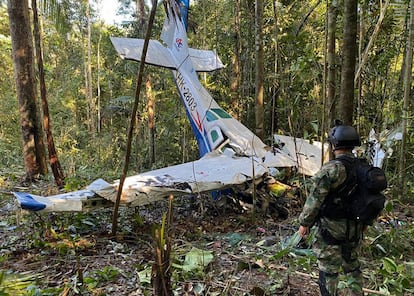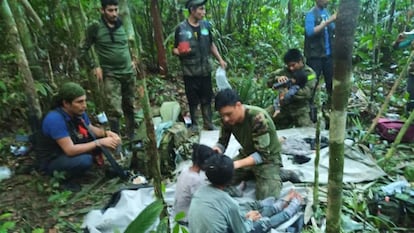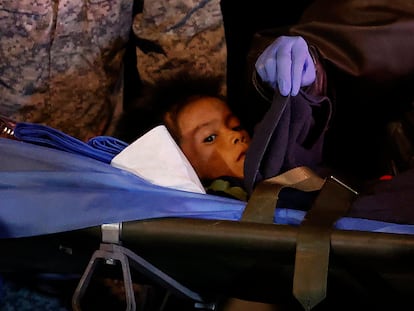Ayahuasca and holy water: How four missing children were found in the Amazon jungle
EL PAÍS speaks with the indigenous volunteers who located the minors, a soldier who rappelled into the forest to find them and the commander leading the search effort about the trials of the 40-day mission

It was the day; the day that the four children missing in the Colombian jungle were going to be found. The night before, a shaman named El Rubio had drunk ayuahsca and had met the children in his dream. He interpreted it as a divine sign. Nicolás, Dairo, Eliezer and Álex, members of the indigenous community of Putumayo, pushed through the jungle with that mystical conviction. They were alone, they had overtaken the soldiers, who were also taking part in the search effort and had come up against the jungle’s thick undergrowth. It was 3 p.m., a time when it was best to start returning to camp before night fell. But Nicolás, Dairo, Eliezer and Álex kept going: they had faith in the shaman’s words. On the way, the four of them ran into a turtle.
“Little turtle, if you don’t deliver the children, I’m going to eat your liver fried,” Eliezer told it laughing.
“And I’m going to drink your blood,” sai Nicolás, more explicitly.
The turtle did not flinch. Eliezer strapped it on his back and carried it with him like a backpack. The trackers advanced another 10 meters, until they reached a clearing. There, Dairo heard in the distance what seemed like the cry of a baby. He estimated that it was coming from about 50 meters away. “It’s the children!” he had the urge to shout. The four bolted forward. Nicolás was the first to reach the children and found Lesly, the eldest, with the one-year-old baby in her arms. He gave her a hug and told her not to be afraid, that they were indigenous people from Putumayo and that they had been looking for them for weeks.
When they were found, the children were in a shelter built with banana leaves, and some sheets that they had taken from the plane that had crashed 40 days earlier. The children, who were traveling at the back of the plane, were unharmed when the aircraft crashed head first into the ground. The three adults who were in the front, including the children’s mother Magdalena, died from the impact. After the crash, the minors wandered alone in Colombia’s Amazon jungle.

The indigenous rescuers — grateful to the gods for finding the children — blew tobacco as an offering to the jungle and sprinkled the children with holy water. The five-year-old boy, Tien, told them that his mother had died in the accident. To alert the others that the children had been found, Dairo hit the root of a bamba, which produces a sound that reaches more than a mile away. But no one answered him back. They were alone and it was going to get dark soon. They had to run, said Dairo. He feared that the forest spirit — the one the indigenou people believed had kept the children captive — would take them away again. So they each carried children and started back to the nearest military camp. When they spotted the soldiers’ uniforms in the undergrowth, Dairo yelled: “We found the target.” The turtle had done its part.
That’s how the search effort that had the world holding its breath came to an end on June 9. It was nothing short of a miracle: not only were the children unharmed in the plane crash; they managed to survive for almost seven weeks in a jungle infested with jaguars, poisonous snakes and toxic plants. Colombia’s special forces and indigenous communities had searched tirelessly for them. They had walked through half the jungle to find them, but in the end, the children were found just three miles (five kilometers) from the site of the crash. How could that happen? One theory is that the children avoided the adults for fear of being scolded and remained quiet when they heard the footsteps of the soldiers.
When the children were found, they were malnourished, suffering from dehydration and covered in mosquito bites. They were taken to Bogotá Military Hospital, while Colombian Institute for Family Welfare (ICBF) — which oversees the care of minors — decides who will be given custody. Their mother, Magdalena — a woman who ran marathons when she was young — died in the plane crash, and their father, Manuel Ranoque, is suspected of mistreating his wife and children. Ranoque is the biological father of Tien and Cristian, who turned one during the 40-day ordeal, and he is the stepfather of Lesly, 13, and the nine-year-old girl, Soleiny. The maternal grandparents argue that Ranoque never took care of his family, and accuse him of being an alcoholic and violent. The government will decide in the coming months what will happen to the children, who have no idea that the country’s thinks of them as heroes.
The army sent more than 100 special forces members to find them. Colombian President Gustavo Petro said that the rescue mission was a national priority. Commando Flores rappelled down into the jungle from a helicopter 60 meters above sea level. He took an M-4 rifle, hand grenades, night vision googles and a satellite phone. He was carrying a weapon in case he came across FARC dissidents, who oppose the peace process and are still up in arms in the most inaccessible places in the country. Flores and his companions began a mission similar to finding a needle in a haystack.

During the month they were immersed in the jungle, they did not shower. The rainwater that ran down their bodies was all that they needed. They did not make coffee and were forbidden to wear deodorant due to concern that the enemy would pick up on the scent. Whiskey or brandy was poured into rivers to satisfy the spirits of the jungle. “We did our research, but we respected indigenous beliefs,” says Flores. They sprinkled tobacco on the ground as a sign of goodwill. At first, the soldiers were very skeptical about the idea that a spirit was holiding the children captive. “But we ended up believing what they said. We found the children’s footprints, but not them. It was as if something supernatural made them invisible. For the record, I believe in God,” he adds.
Lesly, meanwhile, was keeping her siblings alive. The 13-year-old had some ideas about how to survive in the jungle. She lived in Chuquiqui, a community in the town Araracuara, which that grew up around a prison that had been built for the most dangerous criminals. The prisoners did not have cells, they lived outdoors, but were trapped by the omnipresent jungle. Crossing it was certain death. Not for Lesly, who learned as a child how to move through the jungle. She knew how to navigate by the few rays that filtered through the canopy, to spot passable paths and broken branches where someone had passed, and to recognize poisonous plants. According to her maternal family, Lesly sometimes fled from her father’s beatings and hid for two or three days in the jungle.
Lesly lost a pair of scissors a few days after the children went missing, and from then on she used her teeth to cut branches and make shelters. When they ran out of food, she chewed up fruits to put them in a bottle or water bottle to feed the baby. When they found her, she was carrying a bag of fariña, a kind of coarse flour derived from cassava, and milpes, a violet-colored fruit. From the plane, she took some sheets, the fariña, the awning which they used for shelter and the contents of the first-aid kit.
“It was so imaginative,” says Pedro Sánchez, a general of the Colombian special forces, whose eyes water when he speaks of the mission.
When asked about whether he thought the children hid from them for fear of being scolded, he replies: “We were 40 meters away from them, perhaps on the same day, or a day before or after. And they listened to us, both the soldiers and the indigenous people. Lesly heard the helicopter, the speakers with her grandmother’s voice, but I don’t know why she didn’t help us find her more easily. Only she knows that.”

The father, Ranoque, joined the search. He had met Magdalena, the children’s mother, when they both worked in informal mining, extracting gold. To do so, they amalgamated the sediment with toxic substances such as mercury. Once the gold is separated, that mercury is returned to the river, poisoning it. This business is usually in the hands of organized crime. In 2015, they went to live together in a spot very close to Ranoque’s mother. But Magdalena did not get along with her mother-in-law. Ranoque went on to become the governor of the Puerto Sábalo indigenous reservation. At Easter this year, however, he left suddenly, leaving his family behind. Ranoque says he was forced to flee after receiving threats from FARC dissidents, who denied this in a statement. The mother and children caught a plane, which was piloted by a former taxi driver, on May 1, to meet him. The idea was to start a new life in Bogotá, far from the Amazon.
“I entered the jungle on the May 7 and didn’t come out again. I wanted to find them,” says Ranoque. He estimates that he traveled 18.6 miles (30 kilometers a day), which, while near-impossible for a city dweller, is common among indigenous people who live in jungle areas. First he searched in the Apaporis river basin, next to where the plane fell. He also offered cigarettes and brandy to Mother Nature. He chewed powdered coca leaf to connect with the spirits — a process known as mambear. But the days passed and there was no trace of his children. A pain oppressed his chest.
Pedro Sánchez, the commander, also got desperate and went into the jungle himself on June 7. In the undergrowth, he prayed to God with his men and then, opening his arms, said: “Oh, mother jungle, allow these humble mortals to find these children and take them home soon.” He trudged through the mud and tree roots and saw how difficult it was to move on the ground. He met the indigenous people, who had asked him to bring whiskey. Sánchez had ordered it to be bought at the supermarket, but now they told him that it was no longer necessary, that the aguardiente was enough. The spirit was sated. Sánchez saw how tired his troops were after 30 days of searching, so he ordered them to be relieved. Flores was going home.
Sánchez had experienced some very hard times in that month of searching. On May 18, they informed him that they had found a footprint and that it was recent, at most one day old. He believed that the time had come. He mobilized more helicopters, planes, satellite images. “You can’t sleep tonight, you have to go on for 24 hours,” he told the soldiers. They were the most important hours, the golden ones, he says. He used all the resources at his disposal. But after all that effort they found nothing. Sánchez couldn’t believe it, he didn’t know what was preventing them from finding the children.

Another 18 days passed with no word from the children. They had been searching for 36 days. Sánchez was desperate. He went to the chapel to pray and waited for a sign. Nothing was revealed to him. He read the bible to find a passage that would enlighten him, but also to no avail. “Give me some sign, God,” he implored. He only received silence, which he interpreted as a call to keep working and not lose faith. For the indigenous community, the children were in the hands of a spirit, for Sánchez, they were in the hands of Jesus Christ.
He didn’t know it then, but everything was about to be resolved. Commander Cota, one of his soldiers on the ground, called him urgently on June 9. The indigenous rescuers, with the turtle on their backs, had delivered the children.
“Miracle, miracle, miracle,” said Cota, clearly emotional.
It was the code word to indicate the children had been found.
"And how are the children?" asked Sánchez.
“Alive.”
Sign up for our weekly newsletter to get more English-language news coverage from EL PAÍS USA Edition
Tu suscripción se está usando en otro dispositivo
¿Quieres añadir otro usuario a tu suscripción?
Si continúas leyendo en este dispositivo, no se podrá leer en el otro.
FlechaTu suscripción se está usando en otro dispositivo y solo puedes acceder a EL PAÍS desde un dispositivo a la vez.
Si quieres compartir tu cuenta, cambia tu suscripción a la modalidad Premium, así podrás añadir otro usuario. Cada uno accederá con su propia cuenta de email, lo que os permitirá personalizar vuestra experiencia en EL PAÍS.
¿Tienes una suscripción de empresa? Accede aquí para contratar más cuentas.
En el caso de no saber quién está usando tu cuenta, te recomendamos cambiar tu contraseña aquí.
Si decides continuar compartiendo tu cuenta, este mensaje se mostrará en tu dispositivo y en el de la otra persona que está usando tu cuenta de forma indefinida, afectando a tu experiencia de lectura. Puedes consultar aquí los términos y condiciones de la suscripción digital.
More information
Archived In
Últimas noticias
Most viewed
- Reinhard Genzel, Nobel laureate in physics: ‘One-minute videos will never give you the truth’
- Oona Chaplin: ‘I told James Cameron that I was living in a treehouse and starting a permaculture project with a friend’
- Pablo Escobar’s hippos: A serious environmental problem, 40 years on
- Charles Dubouloz, mountaineering star, retires at 36 with a farewell tour inspired by Walter Bonatti
- Why we lost the habit of sleeping in two segments and how that changed our sense of time











































